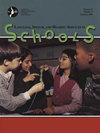Characteristics of Hearing Aid Use in Adolescents Who Are Deaf and Hard of Hearing.
IF 2.9
3区 医学
Q1 AUDIOLOGY & SPEECH-LANGUAGE PATHOLOGY
Language Speech and Hearing Services in Schools
Pub Date : 2025-05-19
DOI:10.1044/2025_lshss-24-00096
引用次数: 0
Abstract
PURPOSE Children who use hearing aids show large individual differences in the amount of time they wear their devices, but the vast majority of research studies have focused on infants and preschoolers who are deaf and hard of hearing (D/HH). There is limited empirical evidence regarding hearing aid use in adolescents or published data on adolescents' attitudes toward hearing aids. The overarching aim of the current study was to characterize hearing aid use in adolescents who are D/HH. METHOD One hundred twenty-nine adolescents who are D/HH (12-19 years old) and their parents completed questionnaires about hearing aid use and attitudes toward amplification. Examiners collected data logging at research visits. Adolescents and parents estimated the average amount of time hearing aids were worn during the week and weekend. We conducted a linear regression analysis to investigate the relationships among the independent predictor variables (chronological age, age at hearing aid fitting, maternal education level, proximity of hearing aid fitting to prescriptive targets, and better ear pure-tone average) and the dependent variable (adolescent self-report of average daily hearing aid use). RESULTS Severity of hearing loss and maternal education level accounted for variation in hearing aid use among adolescents who are D/HH, whereas chronological age, age at hearing aid fitting, and proximity of fitting to prescriptive targets did not. Parent report, adolescent self-report, and data logging were in high agreement, although both parents and teenagers tended to overestimate the amount of daily hearing aid use by around 30 min. DISCUSSION In general, the results of the current study are inconsistent with the notion that adolescents decrease hearing aid use when they reach adolescence. Furthermore, many of the adolescents who participated in this study expressed positive attitudes about amplification, demonstrating emerging self-advocacy.失聪和听力障碍青少年助听器使用的特点
使用助听器的儿童在佩戴助听器的时间上表现出很大的个体差异,但绝大多数研究都集中在失聪和听力障碍的婴儿和学龄前儿童身上。关于青少年助听器使用的经验证据有限,关于青少年对助听器态度的公开数据也有限。当前研究的主要目的是表征青少年D/HH助听器的使用情况。方法1229名青少年(12-19岁)及其父母填写助听器使用情况及对助听器放大的态度问卷。审查员在研究访问时收集数据记录。青少年和家长估计了佩戴助听器的平均时间是在工作日和周末。我们对独立预测变量(实足年龄、助听器验配年龄、母亲受教育程度、助听器验配距离规定目标的接近程度、更好的耳朵纯音平均值)和因变量(青少年自我报告的平均每日助听器使用情况)之间的关系进行了线性回归分析。结果听力损失的严重程度和母亲受教育程度影响了D/HH青少年助听器使用的变化,而实足年龄、助听器配戴年龄和配戴距离规定目标的接近程度无关。家长报告、青少年自我报告和数据记录高度一致,尽管父母和青少年都倾向于高估每天使用助听器的时间约30分钟。讨论总的来说,目前的研究结果与青少年进入青春期后减少助听器使用的观点不一致。此外,参与本研究的许多青少年对放大表达了积极的态度,表现出新兴的自我倡导。
本文章由计算机程序翻译,如有差异,请以英文原文为准。
求助全文
约1分钟内获得全文
求助全文
来源期刊

Language Speech and Hearing Services in Schools
Social Sciences-Linguistics and Language
CiteScore
4.40
自引率
12.50%
发文量
165
期刊介绍:
Mission: LSHSS publishes peer-reviewed research and other scholarly articles pertaining to the practice of audiology and speech-language pathology in the schools, focusing on children and adolescents. The journal is an international outlet for clinical research and is designed to promote development and analysis of approaches concerning the delivery of services to the school-aged population. LSHSS seeks to advance evidence-based practice by disseminating the results of new studies as well as providing a forum for critical reviews and meta-analyses of previously published work.
Scope: The broad field of audiology and speech-language pathology as practiced in schools, including aural rehabilitation; augmentative and alternative communication; childhood apraxia of speech; classroom acoustics; cognitive impairment; craniofacial disorders; fluency disorders; hearing-assistive technology; language disorders; literacy disorders including reading, writing, and spelling; motor speech disorders; speech sound disorders; swallowing, dysphagia, and feeding disorders; voice disorders.
 求助内容:
求助内容: 应助结果提醒方式:
应助结果提醒方式:


